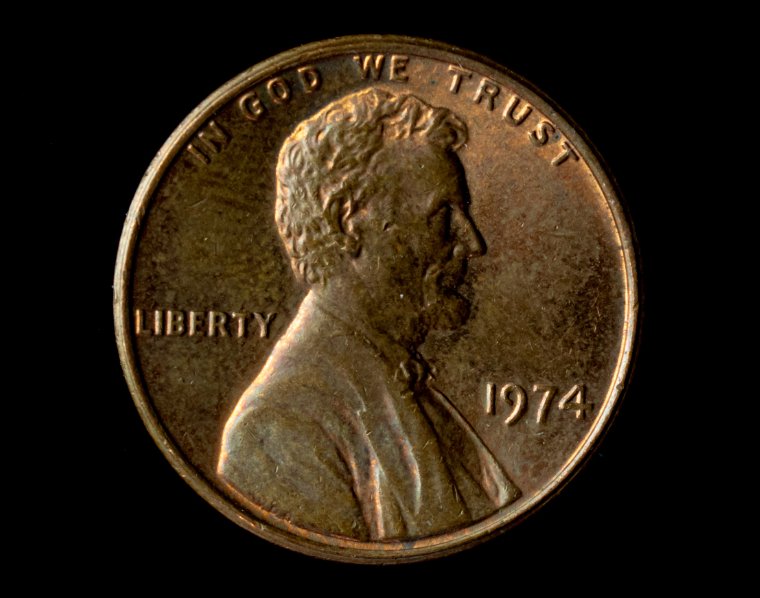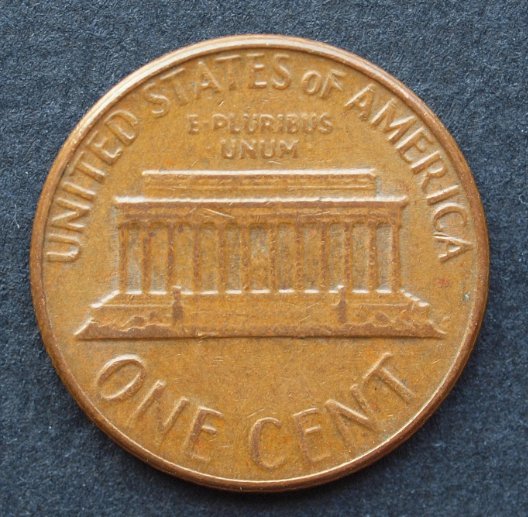Although it looks ordinary, the 1974 Lincoln Penny is way more interesting and valuable than you might think! Packed with some rare features that can hike its value to up to $11,500, this small cent can actually be your jackpot!
So if you have a 1974 Lincoln Memorial Cent, this value guide is just for you! From rare errors and experimental aluminum cents that didn’t make it into circulation, I will introduce you to all the valuable features you must observe to find the actual worth of your 1974 penny before you trade one!
Brief History of the 1974 Lincoln Penny
The 1974 Lincoln penny is a part of the modern Lincoln Memorial Cent series that continued the traditional Abraham Lincoln obverse since 1909 and the new Memorial reverse since 1959. However, 1974 marked a significant year in the coin’s history as it was produced during economic ups and downs.
In the early 1970s, the rising prices of copper made the production of copper pennies expensive. To resolve this, the United States Mint explored alternative metals for pennies, such as aluminum and bronze-clad steel.

However, these experimental pennies faced opposition due to vending machine and X-ray imaging issues and Congress rejected the aluminum alloy in March 1974. However, while most of these cents were disposed of, some were secretly kept by workers, which can be worth a lot today!
While no changes were implemented that year, the cent composition was finally changed into copper-plated zinc pennies in 1982 after copper prices once again skyrocketed in the ’80s.
| 1974 Lincoln Cent | Key Features & Facts |
| Coin Composition | 95% Copper, 5% Tin and Zinc |
| Minting Location | Philadelphia, Denver, San Francisco |
| Minting Year | 1974 |
| Face Value | 1-cent (0.01$) |
| Weight | 3.11 grams |
| Diameter | 19.05 mm |
| Thickness | 1.52 mm |
| Designer | Victor David Brenner, Gilroy Roberts |
| Mint Marks | D – Denver Mint, S – San Francisco no mint mark – Philadelphia Mint |
| Total Mintage | 8,750,320,228 |
How to Identify 1974 Lincoln Penny Design & Composition
The 1974 Lincoln penny features the iconic design that has graced the cent since 1959. Here’s a breakdown of its key features:
1974 Lincoln Penny Obverse:

- Abraham Lincoln’s profile facing right
- The US motto, “IN GOD WE TRUST,” above Lincoln’s head
- The word “LIBERTY” to the left of Lincoln’s portrait
- The mint date “1974” to the right of Lincoln’s portrait
- The mint mark, if present, below the mint year.
1974 Lincoln Penny Reverse:

- Lincoln Memorial building in the center
- “E·PLURIBUS·UNUM” across the top
- “UNITED STATES OF AMERICA” along the bottom rim
- “ONE CENT” above the Memorial building
- Designer’s initials “FG” (for Frank Gasparro) on the right side of the Memorial
Coin Composition, Size, & Dimensions
The 1974 Lincoln penny is composed of 95% copper and 5% zinc and weighs 3.11 grams. Some experimental 1973-struck 1974 cents also had an aluminum composition, but these coins were not released to the public.
As for the size, the 1974 Lincoln Cent measures 19.05 mm in diameter. It has a smooth edge with a thickness of 1.55 mm. This composition gives the coin its characteristic reddish-brown color, though the exact shade can vary due to factors like age and storage conditions.
How to Assess the 1974 Lincoln Penny Value (5 Key Factors)
On average, a circulated 1974 Lincoln penny is worth only its face value of one cent. However, uncirculated pennies and those with rare features can be worth $2,000 or more. Here are all the major factors that determine the value of your 1974 penny coin!
1. Coin Condition and Grading
The first major factor that directly impacts a 1974 Lincoln Penny coin value is its condition. Generally, the penny is professionally graded on a scale from Poor (P-1) to Perfect Mint State (MS-70), where a high grade means excellent, mint condition.
Among these, 1974 pennies graded MS-66 or higher are particularly valuable, while lower ones are only worth a few cents to $10. You can also assess your coin’s condition by examining the details on Lincoln’s profile, like hair and beard, the Memorial, and the lettering of the words.
2. Coin Toning & Coloration
While all 1974 Lincoln cents are reddish-brown in color, old coins may lose their original finish and turn brown due to oxidation and discoloration. This toning significantly affects the coin’s value. Depending on the degree of discoloration, the 1974 pennies are graded as follows:
- Red (RD): 1974 pennies that retain 95% or more of their original mint red luster are graded RD. Generally, these are the only 1974 pennies worth something, often commanding 50-100% more than similar-grade brown cents.
- Red-Brown (RB): Coins with 5-95% of their original red color are graded RB. These are more common than RD 1974 pennies and are valued between red and brown cents.
- Brown (BN): 1974 cents with less than 5% of their original red tint (95% discoloration) are graded BN. These coins are the least valuable.
3. 1974 Lincoln Penny Mint Marks & Mintage
Per other factors, the mintage of a 1974 Lincoln Penny coin also impacts its value. Generally, higher mintage means more availability and less worth. With a total mintage of 8.75 billion cents, the 1974 pennies are typically quite common, but coins from certain mints can be rare and valuable.
You can easily identify the mint location of your 1974 Lincoln Cent by the mint mark present on its Obverse. Here’s a breakdown of its mintage by mints:
- 1974 No Mint Mark Penny: The Philadelphia Mint produced around 4,232,140,000 copper pennies in 1974, all bearing no mint mark. Circulated 1974 no mint mark copper pennies are worth the face value, while uncirculated mint state coins can fetch $0.30-$5, with high-grade examples $500 or more.
- 1974 D Lincoln Penny: The Denver Mint struck 4,235,098,000 1974 pennies, identified by a “D” mint mark. Most common of all, 1974-D pennies in circulated coins are worth face value, with uncirculated cents ranging from $0.30 to $5 and top-grade examples fetching $200 or more.
- 1974 S Lincoln Penny: The San Francisco Mint produced 409,426,660 regular 1974 pennies, with the “S” mint mark. While circulated 1974 S pennies are still worth around the face value, MS67-graded examples, can sell $400 to $2,500 or more, like this one with “Jack Lee” Pedigree on Holder sold for $2.702 on Heritage Auctions.
I’ve crafted a 1974 Lincoln Penny value chart to easily find the average value of a coin based on its condition & condition
| Coin Grades | Condition Details | 1974 No Mint Mark Penny Value | 1974 D Lincoln Penny Value | 1974 S Lincoln Penny Value |
| Poor (0) to Extremely Fine (XF45) | Significant wear, faded but visible details | Face value or slightly more | Face value or slightly more | Face value or slightly more |
| Almost Uncirculated (AU50) to Mint State (MS60) | Slight wear on highest points, visible marks or blemishes | 30 cents to $1 | 30 cents to Below $1 | Below $5 |
| Mint State (MS61 – MS64) | Uncirculated with minimal wear | $1 – $10 | $1 – $9 | $5 – $15 |
| Mint State (MS65 – MS66+) | Nearly flawless with very minor imperfections | $7 – $35 | $7 – $45 | $5 – $150 |
| Mint State (MS67 – MS67+) | Well-preserved with no major flaws | $60 – $800+ | $40 – $500+ | $180 – $1,000+ |
| Mint State (MS68 or Above) | Nearly perfect, luster, no major marks or flaws | N/A | N/A | N/A |
4. 1974 Lincoln Penny Proof Coins
The U.S. Mint produced 2,612,568 proof 1974 Lincoln pennies at the San Francisco Mint. These coins feature sharper details and a mirror-like surface. Like regular coins, the proof cents are also graded on a scale from PR-60 to PR-70.
| 1974 Lincoln Penny Proof Coin Grades | Condition Details | 1974-S Penny Average Value |
| PR-66 | Well struck, minimal marks and hairlines | $2 – $12 |
| PR-67 | Sharply struck, only a few minor imperfections | $5 – $15 |
| PR-68 | Very sharply struck, minuscule imperfections | $10 – $35 |
| PR-69 | Fully struck, nearly imperceptible imperfections | $40 – $1,200 |
| PR-70 | The “perfect coin,” no imperfections at 5x magnification | N/A |
Apart from this, the 1974 Proof coins are also divided into three categories based on the proof finish:
- Regular Proofs: These proof coins have a uniform, mirrored surface, and their values range from $1 to $10 for most examples.
- Cameo Proofs (CAM): CAM-graded 1974 proof cents feature frosted devices (raised areas) contrasting with mirrored fields. They’re more valuable, typically worth $10 to $50.
- Deep Cameo/Ultra Cameo Proofs (DCAM): These proof coins have the highest contrast between frosted devices and mirrored fields. They’re the most valuable, often fetching $50 to $200 or more.
5. Rare Mint Errors and Rarities on 1974 Lincoln Penny
If a 1974 cent has rare mint errors, it can double or even triple its actual value. Here are the most valuable 1974 Lincoln Penny errors to find:
1974 No Mint Mark Aluminum Penny
Although not an error, this coin is extremely rare and valuable. In 1973, when copper prices rose crazily, the US mint decided to strike about 1,571,167 1974-dated aluminum pennies at the Philadelphia Mint to replace the traditional copper cents. But Congress rejected these coins and ordered them to be destroyed.
However, some coins are said to have escaped the authority and acquired by workers. As of now, only one 1974 aluminum penny has been discovered. It was a gold plated aluminum cent, graded “GENUINE” by PCGS, and sold at eBay for $250. The average value of a genuine 1974 no mint mark aluminum penny released by PCGS is a whopping $160,000!
1974 D 1C Aluminum Penny

The experimental 1974 aluminum penny was only authorized to be struck at the Philadelphia Mint. But a rare 1974-D aluminum penny was discovered in 2014 on Randall Lawrence, son of Deputy Superintendent at the Denver Mint, Harry Edmond Lawrence, who said it was a gift from his father.
Later, PCGS graded this coin as the first 1974-D Aluminum Penny with an extremely high value of $260,000 to up to $2 million!
Broadstruck Error
This notable mint error occurs when a coin is struck outside of the collar, resulting in a larger diameter and often a distorted appearance. Depending on the coin condition, a 1974 broadsrtuck penny can be worth $20 to $100, like this MS63RB graded example that sold for $36 on Heritage Auctions. High-grade red pennies can sell for much higher prices.
Off-center Strike
This 1974 Lincoln Penny error happens when the planchet is misaligned during striking. Severe misalignment can also cause a part of the design to get cut out. Depending on the coin condition and rate of off-center strike, this coin can be worth $20 to $200 or more!
Struck on a Clad Dime Planchet
This is a transitional or wrong planchet error in which a 1974-D Lincoln Penny is mistakenly struck on a clad 10C dime planchet. You can identify this rare coin with its size and silvery finish due to its different composition.
A well-preserved circulated 1974 D penny clad dime is worth $100 to $400, like this AU58-graded 1974-D 1C coin that sold for $376 on Heritage Auctions. High-grade coins can easily sell for $500 to $1,000 or more.
Reverse Brockage on 1973-S Cent
This unique error combines two different years on a single coin, making it highly collectible. It happens when a previously struck 1973-S cent gets lodged in the collar and is struck again, resulting in a reverse brockage impression on the 1974-S Lincoln Penny obverse.
An extremely rare error coin to find, one MS64 RB graded example sold for a stunning price of $11,400 on Heritage Auctions in 2020!
Apart from these, you can also find the common mint errors, such as the Doubled Die Obverse, Doubled Die Reverse, and Repunched Mint Mark errors, on a 1974 Lincoln Memorial Cent, which can also impact its value!
How to Spot a Fake 1974 Lincoln Penny?
Differentiating between a fake 1974 Lincoln Memorial Penny and a genuine one might be challenging at times. Follow these simple steps to do so:
- Check the Composition: The first step is to verify the bronze composition of your 1974 penny. You can perform a magnet test; if the coin reacts to the magnet, it’s not purely a copper penny.
- Verify the Dimensions: Measure your 1974 penny precisely to make sure its diameter and thickness match those of genuine pennies. Any deviation might indicate a counterfeit.
- Examine the Mint Mark: Ensure the mint mark’s size, position, and style (if present) are correct for the 1974 issue. Fakes likely have forged marks or wrong mint mark font and size.
- Check the Date Font: The mint date should match the style used in all 1974 issues. Fake cent coins often use incorrect fonts or positioning.
With these easy steps, you can easily verify whether your 1974 cent is real! But if you’re still in doubt, consult a professional numismatist or coin grading service.
In conclusion, the 1974 Lincoln Memorial Cent are generally common and of modest value, but certain factors can transform them into priceless gems. All you need is to observe all the rare features using this guide and find the best price for your coin!
If you’re interested in collecting valuable American pennies, you must also look out for the iconic 1944 penny, 1945 penny, 1968 penny, and the 1982 penny. I’ve shared detailed price guides on each of them for you!
Note: This article is intended for informational, educational, and entertainment purposes only. Some images are illustrative and may not represent actual brands, products, or related entities. All trademarks, product names, brand logos, packaging, and other intellectual property referenced remain the exclusive property of their respective owners. Any brand mentions or references are provided solely for descriptive and educational context and do not imply any formal or commercial association.










